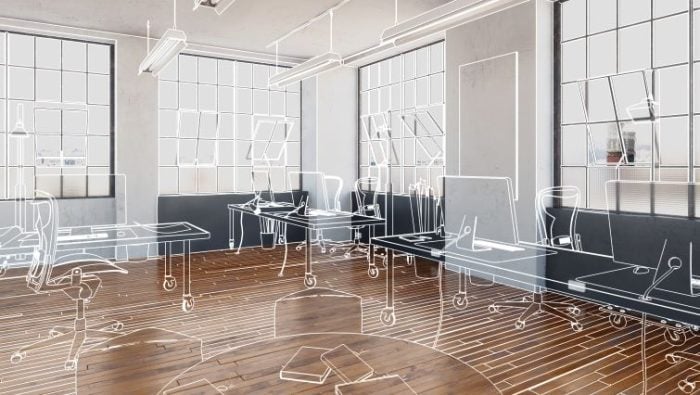Traditional Offices Vs. Coworking Spaces: Which Works for You?
 Publié le 9 March 2021
Publié le 9 March 2021
Learn the pros and cons of traditional offices vs. coworking spaces, and decide which one will best meet the needs of your growing business.
Choosing a physical location for your firm is one of the essential parts of setting up a business. You can either go for a traditional office or a coworking space. Whichever you go for has its limitations and advantages over the other. However, most people are getting tired of staying within the walls of an office. Once it is safe to return to the workplace, some workers want to leave the feeling of staying in a confined office in the past to explore coworking spaces. Whatever you do, you must ensure you are making the right choice of working areas. Here is what you need to know, when comparing traditional offices vs. coworking spaces.
Traditional Offices
Traditional offices have structures designed and built for focus and productivity. They can be in the form of separate offices and cubicles for each individual or have layouts like coworking spaces. Traditional offices usually have designated rooms that serve various purposes. The traditional office gives company leaders more control over your resources and technology for an improved work experience. They also provide individual employees with the needed privacy and pose fewer distractions and conflicts during work. Traditional offices can also serve as headquarters for your company, and you can even brand the office to suit your needs and working conditions.
The traditional office helps you improve and encourage individual work rather than networking and collaboration like in coworking spaces. Handling some clients requires privacy and confidentiality, and you will quickly get that more readily in traditional offices.
Traditional offices also provide you with comfort from their routine. Traditional offices can offer improved efficiency with familiar structures and expectations that do not change on a weekly or even daily basis.
Coworking Spaces
Most coworking spaces usually have an open-layout concept that allows you to share the space with other members. Coworking spaces provide you with an environment supportive of communication and collaboration. They typically have amenities and technological equipment like furniture, Wi-Fi, printers, etc., for every member of the space.
Coworking spaces provide workers with a varied workspace as they allow the movement of workers within the area. It gives workers the ability to meet and network with other workers in the same industry and various other fields. When using a coworking space, you do not have to worry about office management as they often have built-in management, and you also do not have to deal with long-term commitment when using coworking spaces, unlike traditional office leases.
Coworking spaces provide you with the freedom to choose when and where you want to work. The change of scenery in coworking space can also be good for mental stimulation. If you value flexibility, coworking spaces can be the right fit for you.
Limitations to Traditional Offices
Although traditional offices have advantages that make some people prefer it to coworking spaces, it also has its limitations. One of the limitations is the networking inability. You will only be able to meet and interact with the same people in a traditional office, and there it will not be the networking opportunities found in a coworking space.
The traditional office also creates physical barriers between workers, reducing the chance of communication and collaboration. Managing and running a traditional office can also be time and resources consuming, pulling your focus away from other projects.
Running a traditional office comes with a long-term commitment as most traditional offices require a long-term lease with the property owners. These limitations might not be a big deal if you are a financially stable business, but for others who value a smaller overhead, it might be a sign that the traditional office is over.
Limitations to Coworking Space
Although many workers are starting to explore working in coworking spaces, they still pose certain challenges. They can be a bit more expensive than other options, such as committing fully to work-from-home positions, though less expensive when compared to traditional offices. Due to their very nature, there can be many distractions and even potential conflicts as the area can potentially become rowdy with different people.
In coworking spaces, you share resources with other members, meaning that certain tools and pieces of equipment may be unavailable at times. You might not have the privacy you need when having virtual meetings with clients. You also cannot brand the space to your taste as you are not the only one entitled to its use.
Comparison of Traditional Offices vs. Coworking Spaces
Amenities and furniture: The huge difference between coworking spaces and the traditional office is their readily available amenities. When you get a traditional office, it is always empty, requiring you to furnish it to your taste. Unlike the traditional office, coworking spaces are move-in ready, having everything you need for your service.
With a traditional office, you can furnish your work area exactly how you wish. It will also allow you to add only the amenities you need. It will also save you the stress of looking for the right coworking space that suits your needs.
Cost: Cost is an excellent way to compare these two office solutions. It will cost much more to get a traditional office. There will potentially be continuous costs due to the need for maintenance, repairs and upgrades.
Coworking has the potential to save you a lot of overhead as it allows short-term usage, which is not possible in traditional offices. Coworking spaces do not need you to maintain them as they have management in charge of it, reducing the amount of fees required. Given their flexibility, coworking spaces could save businesses money when compared to a traditional office.
Networking: If you want a workspace that provides peak networking opportunities, you will have to choose coworking spaces over traditional offices. Coworking spaces encourage both physical and virtual networking while traditional offices work on individual strength.
Although a traditional office helps you build your unique company and brand in your industry, it does not offer you the same ease and benefits of networking. Coworking spaces will also allow you to connect with people from different job fields, professional backgrounds, and experiences, which will help you broaden your own scope.
Choosing What You Suits Best
Coworking spaces have taken the business world by surprise, providing office amenities, flexibility and affordable rates to companies and workers in various fields. The flexibility in particular offered by a coworking space has appealed to all types of professionals, ranging from freelancers to company leaders seeking to embrace change.
When considering traditional offices vs. coworking spaces, the question remains, “which should I go for?” The type of workspace you should choose depends on your taste, your work, your needs, and other factors that you deem to be important to your business. After considering varieties of factors, you should be able to know if a traditional office or a coworking space suits you best.







